Faisal II
This article needs additional citations for verification. (November 2010) |
| Faisal II | |||||
|---|---|---|---|---|---|
 Faisal in the 1950s | |||||
| King of Iraq | |||||
| Reign | 4 April 1939 – 14 July 1958 | ||||
| Regency ended | 2 May 1953 | ||||
| Predecessor | Ghazi I | ||||
| Successor |
| ||||
| Prime Minister | See list
| ||||
Prince 'Abd al-Ilah | |||||
| Born | 2 May 1935 Baghdad, Kingdom of Iraq | ||||
| Died | 14 July 1958 (aged 23) Baghdad, Arab Federation | ||||
| Burial | Iraqi Royal Cemetery, Baghdad[1] | ||||
| |||||
| House | Hashemite | ||||
| Father | Ghazi I | ||||
| Mother | Aliya of Hejaz | ||||
| Religion | Sunni Islam[2] | ||||
Faisal II (
The only son of
The
Family and early life
Birth and early years

Faisal was the only son of
1941 coup

Faisal's childhood coincided with the
During his early years, Faisal was tutored at the royal palace with several other Iraqi boys. During the Second World War, he lived for a time with his mother at Grove Lodge at
1952 United States tour
In 1952, at age 17, Faisal began plans to visit the United States and its many development projects such as agriculture, power projects, canal systems, and land reclamation schemes. It was of particular interest to the King especially the Irrigation projects as Faisal would later tell the New York press that it was “very much needed in our country."[6]
On the 12th of August, 1952, Faisal began the five-week tour and, along with Regent 'Abd al-Ilah, they first arrived at 11 AM, in the Hudson River on the RMS Queen Mary and were given a tour around the United Nations Headquarters in Manhattan. The next day, Faisal went on a tour of the Empire State Building and after arriving at the City Hall for a reception with Mayor Vincent R. Impellitteri, he famously went to attend a game held in the Ebbets Field. The visit was covered by many news outlets nationwide that many forgot Faisal's original motives for the visit. He would also famously be on the side of Brooklyn Dodgers but reportedly couldn't tell the difference between them and the other team, the New York Giants, in which one of his aides told him that it the team's names are written on their clothes.[6]
In the following days, he would tour the Radio City Music Hall and the Esso Oil Company. On the 16th of August, both would depart from LaGuardia Airport for Washington, D.C. where he met President Harry Truman.[6] Over the following weeks, he would meet other famous Americans such as Dean Acheson, the actor James Mason, and Jackie Robinson, among others.[7][8]
Adulthood
Less than a year after his visit to the United States, Faisal attained his
Hastening Faisal's demise was the decision taken by his regent (later confirmed by him) to allow the United Kingdom to retain a continued role in Iraqi affairs, through


As oil revenues increased during the 1950s, the king and his advisers chose to invest their wealth in development projects, which some claimed increasingly alienated the rapidly growing middle class and the peasantry. The
Plans for Greater Baghdad
During his reign, Faisal initiated large-scale plans for the modernization of Greater Baghdad. The goal of this ambitious project was to improve and develop infrastructure and housing, provide essential public buildings, reform the building industries, and train future Iraqi architects to not rely on Western help. The increase in the economy that subsequently enabled the plans for Greater Baghdad to be developed was due to negotiations with the British-controlled Iraq Petroleum Company in 1952 that achieved an equitable share of oil rights and a substantial increase in Iraq's revenue. Faisal also created the semiautonomous Development Board which consisted of six members including a foreign advisor with the goal of improving living conditions and construction. After various negotiations, the board received a percentage of the annual oil revenue and in 1955 it established a six-year plan with a larger budget, a quarter of which was assigned to public buildings. In an effort to secure the authority of King Faisal II and the Royal Family and to thwart possible tensions, funds needed to be invested in urban areas where it was feared the conflict would potentially appear.
Many architects from around the world were invited, among them were
Despite the contribution to the development of the city, some have criticized Faisal's plans for Greater Baghdad and the many styles that he introduced to be a "Westernization" of Iraq. The plans also acquired international attention as a letter from the British Board of Trade demonstrates that was sent to a number of British architects. Some of the criticism of the plans were used as justification during the 14 July Revolution.[12]
The Arab Federation

On 1 February 1958, neighboring Syria joined with Nasser's Egypt to form the
Faisal, as the senior member of the Hashemite family, became its head of state and the head of the Union Government, and in his absence, Hussein would head the Union Government. The Federation was also open to other Arab countries joining it.[13]
Assassination
An opposition forms
Faisal's political situation deteriorated in 1956, with
14 July Revolution
In the summer of 1958,
Aftermath
Many years later, when the Iraqi historian Safa Khulusi met Al-Ibousi, who was once one of Khulusi's students, and questioned him on his part in Faisal's death, the former student answered, "all I did was remember Palestine, and the trigger on the machine-gun just set itself off".[15][page needed]
During the regime of Saddam Hussein, Faisal II was reburied under a marble tomb located next to that of his father in the restored Royal Cemetery in Baghdad.[16][page needed]
Engagements
Faisal initially asked for the hand of Princess Shahnaz Pahlavi, the eldest daughter of Shah Mohammad Reza Pahlavi. However, the offer was rejected by the princess herself.
In January 1957, Faisal became engaged to Princess Kiymet Hanım, a descendant of the Mamluk dynasty of Iraq. However, the engagement was broken three months later.
At the time of his death, the king was scheduled to marry to Princess Sabiha Fazile Hanımsultan (engagement in September 1957), the only daughter of Prince Muhammad 'Ali Ibrahim of Egypt and Ottoman princess Zahra Hanzade Sultan.
Notable published works
Faisal II was the author of Ways to Defend Yourself (1951), an Arabic book on judo and self-defense, and he printed 50 copies of it and gave it to other kings and leaders on top of them his uncle King Abdullah of Jordan. He also gave a copy of it to the League of Arab Nations hoping to reprint it and distribute it for free to the youth in Arab countries, but that never happened.[17]
In pop culture
- It has been suggested before that Belgian comic creator, Hergé, used young Faisal as the inspiration for the Character of Prince Abdullah of Khemed in the fifteenth volume of The Adventures of Tintin: Land of Black Gold. It's even suggested that the portrait of Prince Abdullah in the same storyline was inspired by the young King's portrait.[18][19]
- Footage of Faisal along with Abd al-Ilah was shown in The Rock 'n' Roll Years episode "1958" in which the events of the 14 July coup were also talked about.[20]
Military ranks
Faisal held the following ranks:[citation needed]
- Admiral of the Fleet, Royal Iraqi Navy.
- Field Marshal, Royal Iraqi Army.
- Marshal of the Royal Iraqi Air Force.
- Air Vice-Marshal (honorary), Royal Air Force.
Ancestry
| |||||||||||||||||||||||||||||||||||||||||||||||||||||||||||||||||||||||||||||||||||||||||||||||||||||||||||||||||||||||||||||||||||||||||||||||||||||||||||||||||||||||||||||||||||||||||||||||||||||||||||||||||||||||||||||||||||||||||||||||||||||||||||||||||||||||||||||||||||||||||||||||||||||||||||||||||||||||||||||||||||||||||||||||||||||||||||||||||||||||||||||||||||||||||||||||||||||||||||||||||||||||||||||||||||||||||||||||||||||||||||||||||||||||||||||||||||||||||||||||||||||||||||||||||||||||||||||||||||||||||||||||||||||||||||||||||||||||||||||||||||||||||||||||||||||||||||||||||||||||||||||||||||||||||||||||||||||||||||||||||||||||||||||||||||||||||||||||||||||||||||||||||||||||||||||||||||||||||||||||||||||||||||||||||||||||||||||||||||||||||||||||||||||||||||||||||||||||||||||||||||||||||||||||||||||||||||||||||||||||||||||||||||||||||||||||||||||||||||||||||||||||||||||||||||||||||||||||||||||||||||||||||||||||||||||||||||||||||||||||||||||||||||||||||||||||||||||||||||||||
Gallery
-
Faisal II stamp from 1949
-
Faisal II stamp from 1953
-
Faisal II with his uncle, Regent Abd al-ilah
-
Faisal II with his cousin, Hussein of Jordan and Uncle, Abd al-ilah
-
Jackie Robinson interviews Faisal II during his visit to the United States, 1952
-
Faisal II at the Imama Reza Shrine, 1957
-
Faisal II in ceremonial uniform
-
Faisal II with his uncle, Abd al-ilah, and other officers in the Iraqi army and behind them on the right appears Pasha Nuri al-Said
-
King Faisal II and Abd al-ilah at Mosul Airport with Rafik Aref, Chief of Staff of the Army, on the right of the picture, and Khalil Jassim al-Dabbagh, the commander of the Mosul site, on the left
-
The Grave of Faisal II in the Royal Cemetery located in Baghdad
Namesakes
Martyr Faisal II College (Kolleyet Al-Shahid Faisal Al-Thani) is a military school in Jordan that was named after him.
See also
- The late Sharif Ali bin al-Hussein – The cousin of King Faisal II who lived in Iraq and had a political platform to establish a constitutional monarchy in Iraq.
- Prince Ra'ad, head of the royal house of Iraq.
- Abdul Karim Qassim.
- Arab Federation, the short-lived union between Jordan and Iraq where Faisal became its head of state.
- History of Iraq.
Notes
- ^ "Iraq renovates Baghdad's Royal Cemetery before King Abdullah visit". Sawt Beirut International. 28 March 2021. Retrieved 17 January 2024.
- ^ "IRAQ – Resurgence in the Shiite World – Part 8 – Jordan & The Hashemite Factors". APS Diplomat Redrawing the Islamic Map. 2005.
- ^ a b Al Sahly, Suadad; Lessware, Jonathan (14 July 2018). "60 years on, Iraqis reflect on the coup that killed King Faisal II". Arab News. Retrieved 10 January 2023.
- ^ S9.com Archived 6 May 2021 at the Wayback Machine. Retrieved on 14 July 2008.
- ^ "Iraqi Boy-King Faisal II's drawings shed light on country's past". 14 June 2021.
- ^ a b c "Doomed Guests: Faisal II, the "Boy King" of Iraq". 23 March 2017.
- ^ "Truman Library Photograph: King Faisal II visiting the Naval Academy". www.trumanlibrary.org. Archived from the original on 8 June 2019.
- ^ "Foreign Relations of the United States, 1952–1954, the Near and Middle East, Volume IX, Part 2 - Office of the Historian".
- S2CID 153649796.
- ^ "Iraq may need what it once had -- a constitutional monarchy". 25 March 2007.
- ^ "جامع احمد الشاوي". Archived from the original on 31 May 2022.
- ^ King Faisal II's plans for Greater Baghdad
- ^ "Al Moqatel - ثورة عام 1958، في العراق".
- ^ "Presidents of Iraq Since 1958". Worldatlas. 3 April 2019.
- ^ "Professor Safa Khulusi". Obituary. The Independent. 5 October 1995.
- ^ "60 years on Iraqis reflect on the coup that killed King Faisal II". Arab News. 20 May 2019.
- ^ https://algardenia.com/mochtaratt/14968-2015-02-14-16-21-07.html In Arabic (the Hobbies of King Faisal II)
- ISBN 978-0-7195-5522-0.
- ^ Giezbert, Franz-Olivier, ed. (2012). Les Personnages de Tintin dans l'Histoire: les Événements qui ont inspiré l'Œuvre de Hergé. Vol. II. Historia.
- ^ "King Faisal II". IMDb.
- ISBN 9781860643316. Retrieved 7 February 2018.
- ^ "Family tree". alhussein.gov. 1 January 2014. Retrieved 8 February 2018.
External links
- "Young King". Time. 17 April 1939. Archived from the original on 14 December 2008. Retrieved 24 November 2017.
- "Revolt in Baghdad". Time. 21 July 1958. Retrieved 24 November 2017.
- "In One Swift Hour". Time. 28 July 1958. Archived from the original on 16 March 2007. Retrieved 24 November 2017.
Further reading
- Khadduri, Majid. Independent Iraq, 1932–1958. 2nd ed. Oxford University Press, 1960.
- Lawrence, T. E. Seven Pillars of Wisdom. Retrieved 14 July 2008
- Longrigg, Stephen H. Iraq, 1900 to 1950. Oxford University Press, 1953.
- Morris, James. The Hashemite Kings. London, 1959.
- De Gaury, Gerald. Three kings in Baghdad, 1921-1958 (Hutchinson, 1961).













